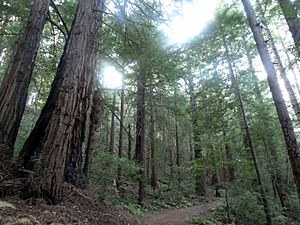Sam McDonald County Park facts for kids
Quick facts for kids Sam McDonald Park |
|
|---|---|

Redwood forest in Sam McDonald County Park
|
|
| Lua error in Module:Location_map at line 420: attempt to index field 'wikibase' (a nil value). | |
| Type | Parkland |
| Location | 13435 Pescadero Creek Road Loma Mar, California |
| Area | 867 acres (351 ha) |
| Created | 1970 |
| Operated by | San Mateo County, California |
| Open | All year |
Sam McDonald Park is a wonderful natural area located between La Honda and Loma Mar in San Mateo County, California, United States. The San Mateo County Department of Parks manages this beautiful park. It covers about 867 acres (which is roughly 3.5 square kilometers) of towering redwood forests, areas with different kinds of trees, and sunny open meadows.
You can explore many trails that lead up to high ridges. From these spots, you'll get amazing views of the Pescadero Creek valley, Butano Ridge, and even the vast Pacific Ocean. The park is home to a special area called Heritage Grove. It also connects to Pescadero Creek County Park, and through that, you can reach Memorial County Park, Portola Redwoods State Park, and even Big Basin Redwoods State Park by following a special path through private land. Many people enjoy horseback riding here, and there's a popular spot called Jack Brook Horse Camp for riders.
Contents
Discover Sam McDonald Park
Sam McDonald Park is a fantastic place to connect with nature. It offers a mix of dense forests and open spaces, perfect for hiking, exploring, and enjoying the outdoors. This park is named after a remarkable person whose vision helped create this protected area for everyone to enjoy.
The Story of Sam McDonald
Emanuel B. (Sam) McDonald was born on January 1, 1884, in Monroe, Louisiana. He was one of seven children in his family. Sam came from a family that worked hard and faced many challenges. He grew up with a strong spirit and a desire to make his own way in the world.
His family moved to southern California in 1890 to farm sugar beets. Later, they moved to Gilroy in 1897, and then to Washington state in 1900. Sam, however, loved California and decided to stay. He separated from his family in Oregon and returned to California in October 1900. He traveled by steamer boat from Sacramento to San Francisco.
While living in San Francisco for the winter, Sam took on various jobs, including working as a model for artists. He also joined the crew of the steamer Modoc, working there until May 1901. After leaving the Modoc, Sam traveled to Alviso by another steamer, the San Jose. He then went to Mayfield to work with horses at the Palo Alto Stock Farm.
By 1903, Sam began working at Stanford University. He first discovered the beautiful Alpine Creek and the redwood forest near La Honda in August 1917 during a vacation. Sam loved this area so much that he started buying land there in 1919. He built a lodge he called Chee-Chee-Wa-Wa. He later named his entire property the La Honda-Alpine-Ytaioa Reserve.
After Sam McDonald passed away in November 1957, he left his land, which was over 400 acres, to Stanford University. In 1958, San Mateo County bought this land for $67,000. They officially created Sam McDonald Park in 1970. Later, in 1976, an additional 450 acres were added from Kendall B. Towne. This brought the park's total size to its current 867 acres.
Exploring the Park's Natural Beauty
Sam McDonald Park is split into two main parts by Pescadero Road. The northwest side covers about 400 acres and is mostly covered with magnificent redwood trees. The southeast side is about 450 acres and features open ridges and grassy hills.
Just east of the park's southeastern half is the Heritage Grove Redwood Preserve. This preserve protects 37 acres of very old redwood forest along Alpine Creek. These ancient trees are truly a sight to behold!
Park Connections and Neighbors
Sam McDonald Park is part of a larger network of parks called the Pescadero-Memorial Park Complex. This complex includes several county parks that have been acquired over time:
- Memorial Park (established in 1924)
- Sam McDonald County Park (land acquired in 1958, park established in 1970)
- Heritage Grove Redwood Preserve
- Pescadero Creek County Park (acquired in 1968)
These parks are also next to Portola Redwoods State Park. They are also close to several areas managed by the Midpeninsula Regional Open Space District. These include the Russian Ridge Open Space Preserve and the Skyline Ridge Open Space Preserve. This whole area creates a huge natural space for wildlife and people to enjoy.

